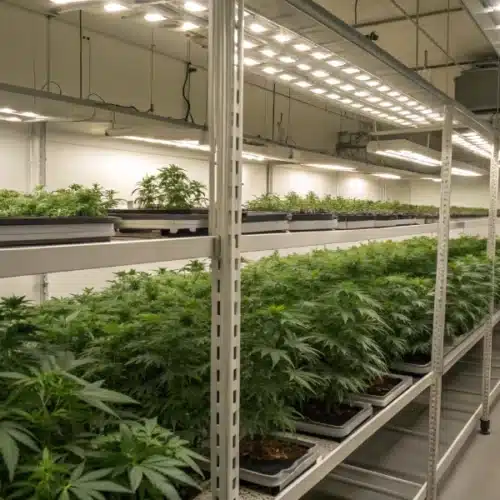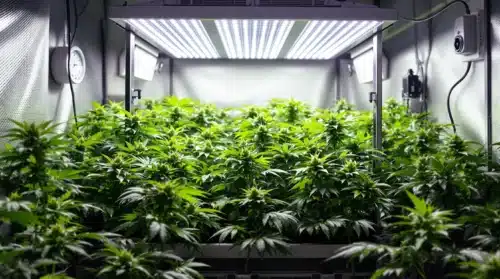As your autoflowering cannabis plants reach their fourth week, they enter a critical phase of development. At this stage, plants transition from vegetative growth to early flowering, setting the foundation for bud production. Understanding the key aspects of autoflower week 4 can help growers maximize yields and maintain healthy plants.
Growth Expectations in Autoflower Week 4
By week 4, most autoflower strains show a significant increase in size and foliage. Expect plants to reach a more mature structure, with bushier growth and pre-flowering signs becoming evident. Pistils may start forming, indicating the onset of bud development.
It is also during this period that the plant’s energy demands increase. Ensuring a steady supply of water and nutrients while monitoring environmental conditions will support healthy development. Maintaining a consistent light schedule and avoiding sudden changes in the environment will help prevent stress and keep your plants thriving.
Promos & Deals
Ideal Environmental Conditions
Maintaining optimal conditions is crucial in autoflower week 4. Aim for:
- Temperature: Keep temperatures between 68-78°F (20-26°C) to prevent stress.
- Humidity: Lower relative humidity to around 50% to prevent mold and mildew.
- Air Circulation: Ensure proper airflow to promote healthy transpiration and prevent stagnant air.
- Soil Moisture: Keep soil consistently moist but not waterlogged to avoid root rot.
- pH Levels: Maintain a pH of 6.0-6.5 for soil and 5.5-6.0 for hydroponics.
- CO2 Levels: Enrich the air with CO2 to promote faster growth and higher yields.
Creating a well-ventilated environment with regular monitoring will minimize the risk of diseases and pest infestations. Investing in hygrometers and thermometers can help maintain stable growing conditions and improve overall plant health.
Lighting Requirements for Autoflower Week 4
Proper lighting is vital as autoflowers transition into the flowering phase. During week 4, adjust light intensity to accommodate the plant’s growing needs.
Recommended PPFD Levels
The optimal PPFD (Photosynthetic Photon Flux Density) for autoflower week 4 should be around 600-700 μmol/m²/s. This range ensures that the plants receive adequate light energy without experiencing stress or light burn.
To optimize light exposure:
- Maintain an appropriate distance between the grow lights and canopy.
- Utilize full-spectrum LED lights for balanced growth.
- Implement a consistent 18/6 or 20/4 light schedule.
- Monitor light stress indicators such as leaf curling and discoloration.
- Rotate plants periodically to ensure even light distribution.
- Consider light deflectors to maximize canopy exposure.
Adjusting light spectrums during this stage can enhance flowering potential. Blue light encourages leaf growth, while red light supports bud development, ensuring a well-balanced plant structure.
Nutrient Requirements and Feeding Schedule
At this stage, autoflowers require a fine-tuned nutrient regimen to support healthy flowering. Autoflower week 4 is when feeding schedules should emphasize bloom nutrients while gradually decreasing nitrogen intake.
Essential Nutrients
Ensure your feeding solution includes:
- Phosphorus (P): Promotes strong root and flower development.
- Potassium (K): Supports overall plant strength and disease resistance.
- Calcium and Magnesium: Prevent deficiencies common during bloom transitions.
- Micronutrients: Such as zinc and iron to support metabolic functions.
- Amino Acids: Enhance nutrient absorption and boost plant resilience.
Balancing nutrient ratios effectively can prevent deficiencies and toxicities. Utilizing slow-release fertilizers can ensure a consistent nutrient supply without the risk of overfeeding.

Training Techniques in Autoflower Week 4
Week 4 presents an excellent opportunity to implement low-stress training (LST) techniques to optimize light penetration and bud exposure.
Effective Training Methods
- LST: Gently bending branches to create an even canopy.
- Defoliation: Removing large fan leaves to improve airflow.
- Support Structures: Adding stakes to support future bud weight.
- Screen of Green (ScrOG): Utilizing a net to maximize light distribution.
- Supercropping: Carefully pinching stems to promote bushier growth.
Training methods should always be done with care to avoid stressing the plants excessively. Proper timing and techniques can result in a higher yield and a more uniform canopy, enhancing light distribution.
Signs of a Healthy Autoflower in Week 4
Healthy autoflower plants in week 4 should exhibit vibrant green leaves, sturdy stems, and symmetrical growth patterns. Pre-flowering pistils should appear, signaling the upcoming transition to full bloom.
If your plant is growing uniformly without signs of drooping or discoloration, it’s a good indicator that environmental factors and nutrients are well balanced. Proper airflow and consistent temperatures will contribute to healthy plant development.
Watering Strategies for Week 4
Maintaining proper watering habits is essential to support robust growth. Watering should be done when the top inch of soil is dry to the touch. Overwatering can lead to root rot, while underwatering may stunt growth.
Using a moisture meter can help ensure accurate watering, and employing a consistent watering schedule will aid in nutrient absorption. Deep watering techniques can also be beneficial to encourage strong root growth.
Organic vs. Synthetic Nutrients
Choosing between organic and synthetic nutrients can impact plant health and yield. Organic nutrients offer a slower release of essential elements, improving soil health over time, while synthetic nutrients provide immediate availability and precise control.
Many growers find a hybrid approach beneficial, combining the advantages of both nutrient types to support growth. Organic options enhance microbial life, while synthetic fertilizers offer consistency and control.
Leaf Health and Deficiency Identification
Monitoring leaf color and texture is key to detecting potential nutrient deficiencies. Yellowing leaves can indicate nitrogen deficiency, while dark spots might suggest calcium or magnesium imbalances.
Regular inspections can help catch issues early and prevent them from affecting overall plant health. Implementing foliar feeding can also address deficiencies quickly.
FAQs About Autoflower Week 4
Should I increase nutrients in week 4?
Gradually introduce bloom nutrients while reducing nitrogen levels to support the flowering phase. Ensuring the right balance of phosphorus and potassium is key to healthy bud formation. Overfeeding should be avoided as autoflowers are more sensitive to nutrient excess compared to photoperiod strains.
How often should I water during week 4?
Water when the top inch of soil is dry, typically every 2-3 days depending on environmental conditions such as humidity and temperature. It’s important to monitor the plant for signs of underwatering or overwatering, such as drooping leaves or yellowing.
What lighting schedule is best in week 4?
An 18/6 or 20/4 light schedule provides optimal growth conditions, balancing light exposure with periods of darkness to allow the plant to rest and carry out important metabolic processes. Ensuring consistent light cycles can help maximize growth and bud production.
By following these guidelines, you can ensure your autoflower plants stay healthy and produce high-quality yields.
















